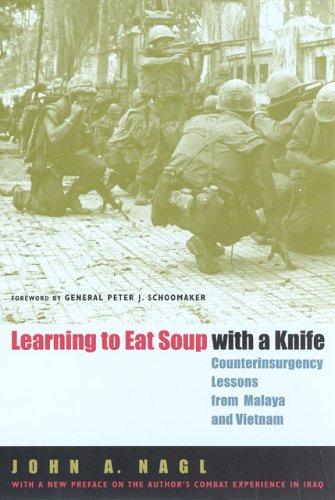Zelanator reviewed Learning to Eat Soup with a Knife by John A. Nagl
Review of 'Learning to Eat Soup with a Knife' on 'Goodreads'
4 stars
I purchased this book on Audible. Somewhat of a mistake, though. The first and last chapter use the term "organization/organizational" too many times to count and it becomes quite a drag listening to it on audio! The Audible narrator is excellent, though, and for roughly 7.5 hours of the 8.5 hour tape you will find it very enjoyable.
With that aside, this is probably one of my favorite books on Counterinsurgency Operations (COIN) because Nagl does an outstanding comparative history of the British Malayan Emergency and the American War in Vietnam. I personally love comparative history and especially when someone does it so well. Nagl acknowledges the many differences—in longevity, intensity, and demographics—that affected how Britain and the United States approached each conflict. However, his central contention is that the British military represented a learning culture while the American Army was not. Therefore, the British success in Malaya and the …
I purchased this book on Audible. Somewhat of a mistake, though. The first and last chapter use the term "organization/organizational" too many times to count and it becomes quite a drag listening to it on audio! The Audible narrator is excellent, though, and for roughly 7.5 hours of the 8.5 hour tape you will find it very enjoyable.
With that aside, this is probably one of my favorite books on Counterinsurgency Operations (COIN) because Nagl does an outstanding comparative history of the British Malayan Emergency and the American War in Vietnam. I personally love comparative history and especially when someone does it so well. Nagl acknowledges the many differences—in longevity, intensity, and demographics—that affected how Britain and the United States approached each conflict. However, his central contention is that the British military represented a learning culture while the American Army was not. Therefore, the British success in Malaya and the American defeat in Vietnam is best explained by differences in the organizational culture of the two national armies—that is, the accumulated body of knowledge and practice that guides how each military (as an organization) functions and perceives its ideal role in prosecuting wars. In Malaya, the British confronted an insurgency and under the direction of Gerald Templar and Oliver Littleton the armed forces successfully improvised and adopted ingenious Psy-Op counterinsurgency tactics to dilute the Malayan insurrection. On the other hand, the American military establishment—especially the higher-ups in MACV MAG—were so thoroughly entrenched in the theory of conventional war that they consistently ignored the innovative ideas of their subordinates in the field. As Nagl summarizes in the concluding chapter: the United States possessed only a hammer and every problem in Vietnam began to look like a nail.
There's a lot to this fairly concise book and definitely more than I can cover in a brief review. Let it suffice that if you are interested in reading up on COIN I would recommend Nagl. You won't need a lot prior knowledge about COIN or either of the conflicts to follow along with Nagl's arguments.


